Zvartnots Cathedral › First Intermediate Period of Egypt » Ancient origins
Articles and Definitions › Contents
- Zvartnots Cathedral › Antique Origins
- First Intermediate Period of Egypt › Antique Origins
Ancient civilizations › Historical and archaeological sites
Zvartnots Cathedral › Antique Origins
Definition and Origins
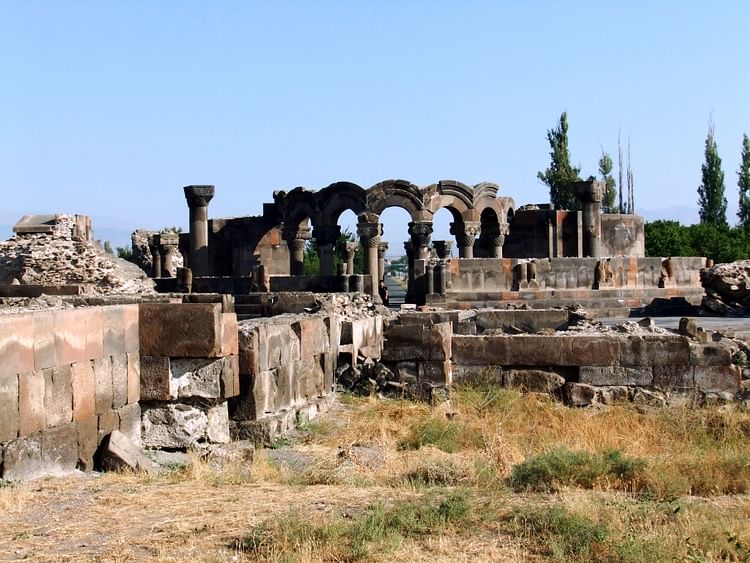
The ruins of Zvartnots Cathedral are located on a flat plain within the Ararat Plateau between the cities of Yerevan and Etchmiadzin in Armenia ’s Armavir province near Zvartnots International Airport. Built in the middle of the 7th century CE, under the instructions of the Catholicos Nerses III (r. 641-661 CE), Zvartnots is the oldest and largest aisled tetraconch church in historical Armenia. Its design strongly influenced later constructions of other Armenian churches with central-domed cross-halls, leaving an enduring architectural and artistic mark in what is present-day Armenia, Georgia, Azerbaijan, and eastern Turkey. Although largely destroyed in an earthquake in the 10th century CE, Zvartnots Cathedral was excavated and rediscovered between 1900-1907 CE. It was partially reconstructed in the 1940s CE - based on the research of the Armenian architectural historian Toros Toramanian (1864-1934 CE) - and Zvartnots' ruins can be visited today. UNESCO added the ruins of Zvartnots Cathedral to its World Heritage List in 2000 CE.
BACKGROUND HISTORY
Zvartnots Cathedral was constructed at a time of much chaos in Near East. After decades of intermittent warfare between the Sasanians and Byzantines, Arab invaders carrying the Islamic faith had surged out of the Arabian Peninsula, taking control of Jerusalem and Alexandria from the Byzantines, and vanquishing the formidable Sasanian Empire in what is now Iraq and Iran. As Armenia lies in the Caucasus and functioned as a geographical bulwark on the Byzantine Empire ’s eastern frontier, it quickly became a contested region between the Arabs and Byzantines. The first Arab invasion of Armenia occurred in 640 CE, and the Arabs massacred thousands of Armenians at the ancient capital of Dvin in 642 CE. From 643-656 CE, the Arabs launched a full-scale invasion of the Caucasus only to be halted temporarily by the armies of the Byzantine EmperorConstans II (r. 641-668 CE). While many Armenians were grateful for Byzantine aid, many were worried about increasing religious influence and interference from Byzantium.
NERSES III BUILT HIS CHURCH ON THE SITE WHERE IT WAS BELIEVED THAT ST. GREGORY “THE ILLUMINATOR” CONVERTED KING TIRIDATES III OF ARMENIA TO CHRISTIANITY.
Armenians were divided in the 7th century CE between those who wished for the Armenian Apostolic Church to accept decisions made at the Council of Chalcedon in 451 CE, which condemned the belief of one incarnate nature of Christ, and those who did not and wished to maintain the separation between the Eastern Orthodox and Armenian Apostolic Churches.Things became more divisive when due to the presence of Byzantine troops on Armenian soil, the Armenian Apostolic Church was placed under the jurisdiction of the Patriarchate of Constantinople in 647 CE by Constans II. (This was subsequently rejected by an Armenian Apostolic Church council a year later.) Nerses III “the Builder” had been elected as the Catholicos of the Armenian Apostolic Church in 640 CE just as the Arab armies arrived in Armenia. During this era, the Armenian Catholicos - the head of the Armenian Apostolic Church - held both temporal and spiritual power over the Armenian people, and so Nerses III exercised and wielded considerable political might.
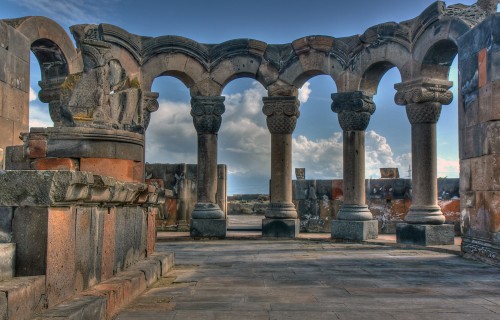
Zvartnots Cathedral
Constans II visited Nerses III in Armenia in 652 CE in order to expand Byzantine influence in matters concerning religion as well as in the development a mutual, common defense against the Muslim Arabs. Nerses III was pro-Byzantine in both his religious and political views; he was fluent in Greek, served in the Byzantine army, and even visited Constans II's court in Constantinople in 654 CE. Constans II found Nerses III to be a most useful and much-needed ally due to his fear of further Arab invasions as well as potential clashes between Byzantine and Armenian soldiers over their religious differences.
ARCHITECTURAL DETAILS & ARTISTIC ELEMENTS
According to the History of Heraclius, widely attributed to the Armenian bishop Sebeos (fl. 7th century CE), the construction of Zvartnots Cathedral began c. 645 CE and continued with occasional interruptions due to Arab razzias into the 650s CE.Armenian legends hold that Constans II was in attendance at Zvartnots' consecration, but there is no historical evidence of this. Sebeos attests that Zvartnots Cathedral was built “to the glory of God.” “Zvartnots” means “heavenly host” in Armenian, which in turn might be a pun derived from the Greek “ egregoros,” which means translates as “powers of angels” or heavenly host.” Some scholars contend that the Armenian root word “ Zawr ” relates to the military and that “Zvartnots” could even be translated as “celestial militia.” The church was designed for congregational worship, but there is a consensus among historians that Nerses III intended Zvartnots Cathedral to be a monument to Armenian-Byzantine ties in addition to functioning as a projection of his own power as an intermediary between Byzantium and Armenia. (It should be noted that Nerses III was also responsible for the construction of the St. Gevorg Chapel at Khor Virap Monastery -- this structure lies 47 km (29 mi) southeast of Zvartnots Cathedral -- which was constructed at the same time.)
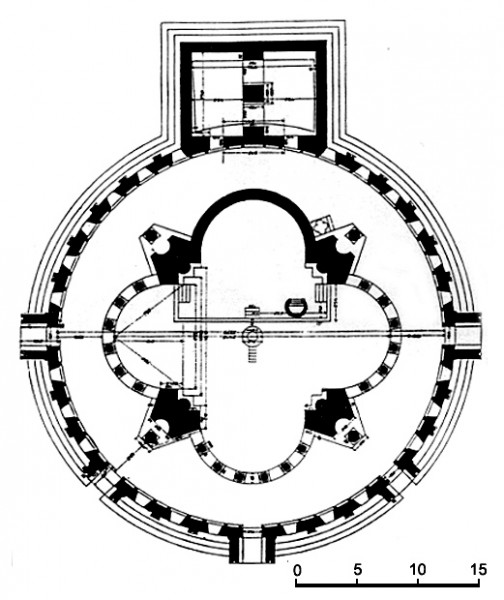
Zvartnots Cathedral Plan
Nerses III built his church on the site where it was believed according to local tradition that St. Gregory “the Illuminator” (c. 257 – c. 331) converted King Tiridates III of Armenia (r. 287–330 CE) to Christianity. Its design as an aisled tetraconch church recalls similar structures across the Roman Mediterranean in what is now Italy (San Lorenzo in Milan), Egypt (Abu Mena), and Syria (Bosra, Rusafah, and Apamaea). Of those, Zvartnots Cathedral resembles most the structures from Syria, which date from the second half of the 5th century CE.
Zvartnots was constructed largely from basalt quarried nearby, along with tufa, pumice, and obsidian. The cathedral contained four W-shaped piers to support its large dome, which in turn divided the cathedral's interior and exterior spaces. Zvartnots' dome reached a height of about 45 m (148 ft), and the entire structure of the cathedral sits on a stone platform that is 5 m (16 ft) tall. The cathedral's core was dominated by a circular ambulatory and a large chamber with an unknown function. There once existed an ambo to the southeast of the cathedral apse as well. The cathedral was sumptuously ornamented with mosaics and well furnished. From the ruins, scholars have deduced that the cathedral's exterior was richly decorated with carvings of pomegranates, grapevines, as well as figural ornaments and graced blind arcades. Nerses III built a small palace for himself directly adjacent to Zvartnots with elegant colonnaded porches.
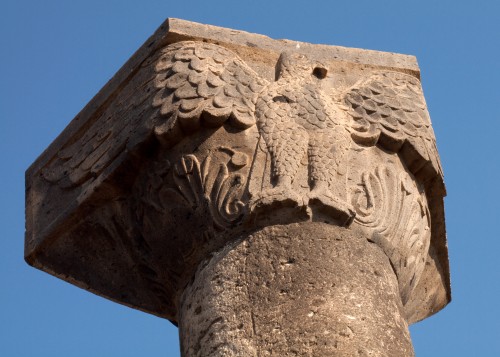
Zvartnots Cathedral
Unlike earlier Armenian churches or religious structures, Zvartnots contains columns with Ionic capitals, which were not common in Armenian architecture in the 7th century CE. Columnar exedrae placed between the piers of the cathedral contained Nerses III's personal monograms in Greek rather than Armenian. Capitals with monograms or personal devices were virtually unknown in ancient Armenia, but they were common throughout the Roman and Byzantine Empires with the best examples being those of the Emperor Justinian (r. 527-565 CE) and Empress Theodora (c. 500-548 CE) at the Hagia Sophiain Constantinople. Four column capitals decorated with eagles once stood in front of the cathedral's four main piers, facing the ambulatory. The eagle with outstretched wings was a potent symbol of imperial Byzantine power. A unique sundial with an Armenian inscription found by archaeologists likely occupied a position somewhere on the southern façade of the cathedral;additionally, a Urartian stele found within the premises of the cathedral was likely reused either for decor or for some structural purpose.
ARTISTIC LEGACY & REDISCOVERY
Zvartnots Cathedral provided the architectural blueprint for many fine churches throughout the Caucasus and Eastern Anatolia, including a ruined church in Bana, Turkey; a ruined Armenian church in Lekit, Azerbaijan; and the Church of St. Gregory in Ani, Turkey. The modern Holy Trinity Church in Yerevan, Armenia is also modeled on Zvartnots Cathedral.Historians believe that Zvartnots Cathedral collapsed following an earthquake in the 10th century CE. It was largely forgotten until it was excavated in 1900-1901 CE.
This article was made possible with generous support from the National Association for Armenian Studies and Researchand the Knights of Vartan Fund for Armenian Studies.
First Intermediate Period of Egypt › Antique Origins
Definition and Origins
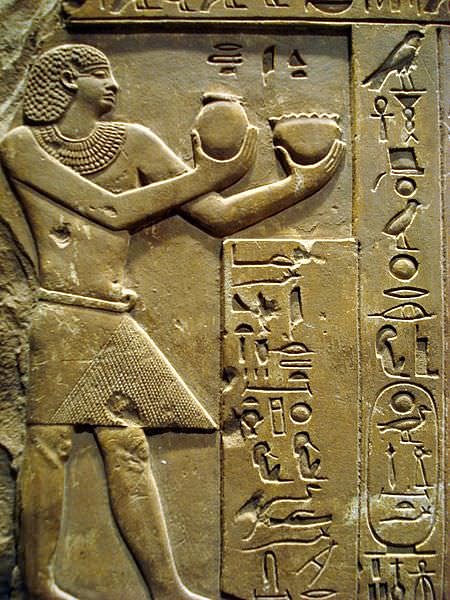
The First Intermediate Period of Egypt (2181-2040 BCE) is the era which followed the Old Kingdom (c. 2613-2181 BCE) and preceded the Middle Kingdom (2040-1782 BCE) periods of Egyptian history. The name was given to the era by 19th-century CE Egyptologists, not by the ancient Egyptians. Stable eras of Egyptian history are referred to as 'kingdoms' while eras of political strife or instability are known as 'intermediate periods.' This period has long been labeled a 'dark age' when the central government of the Old Kingdom, which had been built on the model of the Early Dynastic Period in Egypt (c. 3150-2613 BCE) collapsed and plunged the country into chaos. Recent scholarship has revised this opinion, and now the First Intermediate Period is seen as a time of change and transition, where the power and customs dictated by the monarchy at Memphis, capital of the Old Kingdom of Egypt, were disseminated throughout the country to those of traditionally lower status.
Probably the best way to understand the First Intermediate Period of Egypt is to consider modern retail capitalism and mass consumerism. In the mid-19th century CE (c. 1858) the American department store Macy's in New York City boasted that they sold "Goods suitable for the millionaire at prices in reach of the millions" (14th Street Tribune, 2). Prior to the Industrial Revolution and mass consumerism, certain goods were available only to the wealthy who had the disposable income to spend on such purchases. With the rise of department stores like Macy's, following the Industrial Revolution and mass production, these kinds of goods, though of lesser quality, were available to anyone at a much-reduced cost. This is precisely what happened during Egypt's First Intermediate Period. Those who previously could not afford elaborate homes, gardens, tombs, tomb inscriptions, or their own Pyramid Texts to guide them through the afterlife now found that they could because wealth was no longer only in the hands of the upper-class nobility. Whereas once only the king was provided with tomb inscriptions in the form of the Pyramid Texts, now nobility, officials, and ordinary people were also provided with a guide book to the underworld through the Coffin Texts.
This was possible because of the collapse of the central government at Memphis and the rise of individual nomarchs(governors or administrators of nomes, Egyptian districts) who finally held more power than the king of Egypt. Throughout the Old Kingdom's 4th Dynasty, a great amount of resources and manpower had gone into the construction of the pyramids and mortuary complexes at Giza, and as this site grew, so did the power of the priesthood who administered and cared for the site and others like it. Mortuary priests, especially those attached to the sun god Ra, began to amass more wealth than many nobles. The priests were powerful enough to influence the local officials, and as the priests gained more power so did the nomarchs. As individual nomes became more wealthy, more people could afford to purchase goods and services which had earlier been available only to the wealthy.
IT WAS A PERIOD OF CHANGE & TRANSITION, WHERE THE POWER AND CUSTOMS DICTATED BY THE MONARCHY AT MEMPHIS WERE DISSEMINATED THROUGHOUT THE COUNTRY TO THOSE OF TRADITIONALLY LOWER STATUS.
This rise of the priesthood, coupled with other factors such as the lack of a successor for the long-lived Pepi II and a severe drought, brought about the collapse of the political structure of the Old Kingdom and moved Egypt into the First Intermediate Period, but, again, this should not be seen as a 'dark age' or an age of chaos. It was a period of change for Egypt, and when that change was assimilated into the culture, the country emerged into the era of the Middle Kingdom and went on. The lack of reliable records, especially for the 7th and 8th Dynasties, contributes to the reputation of the era as a 'dark age' as does the quality of the art and architecture produced. Further, the lack of a strong central government - and the friction between Lower and Upper Egypt - has characterized this era as chaotic and lawless. Although the country lacked the unity it had maintained since the time of Narmer (also known as Menes, c. 3150 BCE), Egypt in the First Intermediate Period was far from the frenzied chaos traditionally assigned to it by later writers. This period ended with the rise of Mentuhotep II of Thebes (c. 2061-2010 BCE) who united the country under his rule and initiated the time known as the Middle Kingdom of Egypt.
THE NATURE OF THE FIRST INTERMEDIATE PERIOD
During the time of the Old Kingdom, the rulers diverted enormous resources into mortuary complexes such as that at Giza plateau with its famous pyramids. As these elaborate complexes became more numerous, they required more priests and functionaries to care for them. The primary necropolis of the Old Kingdom was at Giza, but there were also mortuary complexes at Saqqara and Abusir and elsewhere. The rulers of the Old Kingdom also delegated responsibility to the nomarchsand lesser administrators who carried out their duties in accordance with the king's wishes. As historian Marc van de Mieroop notes:
One man alone never held the all-encompassing powers of the center, even if the rhetoric of the Old Kingdom made the king the source of all authority. Kings needed officials to run the complex operations of the court and had always rewarded these people, including with gifts of burials and of mortuary cults that received provisions from estates set aside for the purpose. (86)
During the 5th Dynasty of the Old Kingdom, the king Djedkare Isesi (2414-2375 BCE) decentralized the government and delegated more responsibility to these nomarchs. At the same time, the resources of the royal treasury were enriching the priests at these mortuary complexes and the gifts of the king to nomarchs were further draining funds from the throne and enriching the provincial regions.
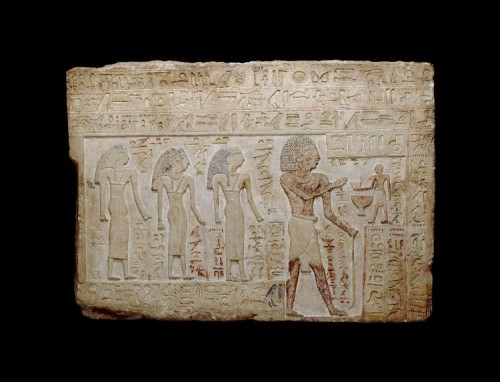
Intef
The First Intermediate Period, therefore, is chiefly characterized by an increase in the power of provincial administrators of separate regions and a decrease in that of the central government at Memphis. This shift in power is evident in every aspect of the archaeological and literary evidence. The great monuments of the Old Kingdom on the scale of the pyramids at Giza were no longer built in the First Intermediate Period because there was no powerful central ruler to commission and pay for them and no bureaucracy to organize the sizeable labor force. The lack of imposing monuments from this period, as well as the inferior quality of the artwork and a lack of historical records (the king's names and dates are either missing or confused for the 7th through the 10th Dynasties) encouraged early scholars of Egyptian history to conclude that the Old Kingdom's collapse threw Egypt into a period of chaos and confusion but, as noted, this is not so. Egyptologist Stephan Seidlmayer writes:
First Intermediate Period archaeological and epigraphic data indicate the existence of a thriving culture among the poorer levels of society as well as vigorous development in the provincial towns of Upper Egypt. Rather than being an outright collapse of Egyptian society and culture as a whole, the First Intermediate Period was characterized by an important, though temporary, shift in its centres of activity and dynamism. (Shaw, 110)
The claim that the culture fell apart might only be true from the point of view of an aristocrat living at the time. The old order of a king and central government was replaced by the regional governments of the nomarchs even though, in the early years of the era, the kings still tried to govern from Memphis. As their power became increasingly diminished, however, the separate regions flourished and the old paradigm was upset. Egyptologist Barbara Watterson comments on this:
The loss of central authority during the First Intermediate Period should have led to a breakdown in social order, but Egyptian society remained hierarchical, with local governors taking over as leaders of society. In the period following the end of the Old Kingdom, people of quite low status in society owned tombs, hitherto restricted to the privileged, often employing local craftsmen of limited talent to build them. Most of these tombs, being made of mud-brick, have disappeared: but many of the stone funerary stele associated with them have survived. The stelae are engraved with short biographies of the occupants, men proud of their own localities and intensely loyal to the local rulers, who, during the First Intermediate Period, provided for their welfare while maintaining social order. (52)
Those claiming the First Intermediate Period was a disaster for Egypt are only basing their conclusion on the point of view of the upper class and the traditional conception of Egyptian government from the Early Dynastic Period through the Old Kingdom. Egyptian history up until this time focused on the king and his accomplishments, but with the decline of centralized power the common people of Egypt took center stage and left behind their own stories, limited as they are. As Siedlmayer notes, during this era "rural Egypt became economically richer and culturally more complex" (Shaw, 112). The focus was no longer on the king but on the regional administrators and the lives of those in his district. Siedlmayer writes:
In the closed political system of the Old Kingdom, the king had been the sole source of legitimate authority. All actions of the officials relied on his command and he judged and rewarded their merits. When the power of kingship faded, however, a more open situation emerged. Now, local rulers could act in accordance with their own aims. (Shaw, 121)
The cultural picture which emerges from an examination of the evidence from the time does not support a chaotic 'dark age' but simply a different social and political paradigm from what had gone before. The poor image of this era, as noted, is due to a lack of historical records and the tendency of early scholars to accept later literary works as historical documents.
THE LACK OF RECORDS & THE IPUWER PAPYRUS
The most serious difficulty in understanding this period is obviously the lack of historical records. The Old Kingdom had preserved Egypt's history in stone through the construction of the pyramids and mortuary complexes, which told their stories.In the First Intermediate Period, with no central government to manage affairs, each individual district took care of itself with greater or lesser care given to preserving the history of the time. Later periods looked back on this time as a 'dark age' because it seemed so antithetical to Egyptian values. The most important concept to ancient Egyptians was harmony ( ma'at ) and the time of the First Intermediate Period was far from harmonious. The king had been seen as a representative of the gods, as a son of god, who maintained harmony in the lives of his subjects as a divine mandate. Siedlmayer writes how the Egyptians felt that "people would be helpless without their rulers. Left on their own, they would simply not be able to face the hazards of life" (Shaw, 120). This continued to be the prevailing view long after the First Intermediate Period, as Marc van de Mieroop notes:
The First Intermediate Period appears in several works of the Middle Kingdom, always in negative terms as a time of disturbance. While historians in the past took these descriptions as accurate reflections, today we see these works, written at least 50 years after the reunification of Egypt, as expressing anxieties of the Middle Kingdom people. They are not a source for the First Intermediate Period, which remains difficult to study. (79-80)
The works of the Middle Kingdom which van de Mieroop refers to almost universally depict a dark and lawless time when there was no king in the land and chaos reigned. The most famous of these works is the Ipuwer Papyrus (known as The Lamentations of Ipuwer or The Admonitions of Ipuwer ) in which a Middle Kingdom scribe laments the depths to which the country has fallen. The Ipuwer Papyrus has long been held to refer to the time of the First Intermediate Period, and this interpretation has greatly influenced scholars and historians in the past who depicted the time as a 'dark age.' To a very significant degree, however, the speaker in the Ipuwer Papyrus is simply lamenting a change in the social structure which he does not approve of:
Poor men have become men of wealth. He who could not afford sandals owns riches. The robber owns riches, the noble is a thief... Gold, Lapis lazuli, silver, and turquoise, carnelian, amethyst are strung on the necks of female slaves [while] noblewomen roam the land.
The Ipuwer Papyrus also mentions how there is "no man of yesterday" and "that has perished which yesterday was seen" lamenting the past and the way life once was. The numerous mention of how those of lower status are now behaving as nobility reflects a nostalgia for a time when social class was more strictly adhered to, a time much more to the writer's liking.The line, "every dead person is as a well-born man" objects to people of lower status now being able to afford the kinds of tombs only the wealthy and nobility once could. Further, the scribe laments the poor quality of goods in his age complaining, "materials for every kind of craft have come to an end," which has been interpreted as referring to the mass production of goods in Egypt during this time. The poorer quality of the arts, when compared to the Old Kingdom, is one of the reasons why scholars initially viewed the First Intermediate Period as a time of collapse and cultural degeneration. The reason why the goods were not of as high quality was because they were now mass-produced for mass consumption.
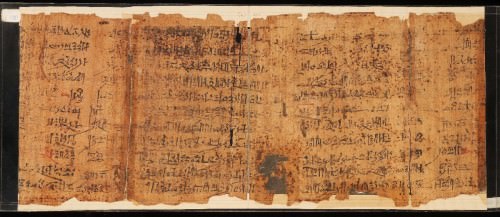
Ipuwer Papyrus
All of this makes it very tempting to link the Ipuwer Papyrus to a description of the First Intermediate Period - which is precisely what has been done - but there is really no reason for this. The Ipuwer Papyrus is literature, not history, and deals with a theme which was very popular in Egyptian writing, as scholar Miriam Lichtheim notes, that of "order vs. chaos" (150).According to Lichtheim, the Ipuwer Papyrus has nothing to do with the First Intermediate Period, and there are plenty of scholars who now agree with her. Still, owing to the lack of historical records from the time, and the similarity in social structure depicted (people of lower status now able to afford luxuries), many very fine scholars and historians have followed the lead of earlier writers in accepting Ipuwer's complaints as an accurate depiction of life during the First Intermediate Period. Even a historian of the stature of Margaret Bunson writes that the First Intermediate Period was "an age of turmoil and chaos that began with the collapse of the Old Kingdom" (78). That there was turmoil during the era is undeniable, but the 'chaos' so often referred to seems an exaggeration.
Further, the Ipuwer Papyrus has been linked to other periods and events as well, including the plagues from the biblical Book of Exodus, which the God of the Hebrews sends down upon Egypt. In the same way that Ipuwer has nothing to do with the First Intermediate Period, neither has it any historical light to shed on the biblical narrative. Narratives lamenting a time gone by, wishing for 'the good old days,' and complaining about the present state of one's life exist in every culture from ancient times to the present moment, and the Ipuwer Papyrus is one of many.
THE TWO KINGDOMS
The claim of turmoil and alleged chaos does have some historical support, however, and comes from the lack of a single strong central government and the division of rule between two kingdoms: Herakleopolis of Lower Egypt and Thebes of Upper Egypt. The 7th and 8th Dynasties of Egypt continued to rule from Memphis but, really, only had control over the local population. The various districts of the country were basically self-governing. The lack of knowledge of the kings of the 7th and 8th Dynasties is testimony to how ineffectual they were. Their names and dates have no lasting resonance in Egyptian history.At some point, the old capital at Memphis was abandoned by rulers there who saw themselves as successors of the Old Kingdom kings. These rulers of the 9th and 10th Dynasties (whose names and dates are so confused they barely make sense) then claimed the city of Herakleopolis as their capital and proclaimed themselves the true kings of Egypt. Siedlmayer writes:
We know very little about the eighteen or nineteen kings who made up Manetho's Herakliopolitan Dynasty, occupying the throne of Egypt for a period of perhaps 185 years. Even their names remain largely unknown, and, with only one or two exceptions, it is impossible to assign the few named kings to their correct places within the dynastic sequence. In addition, none of the lengths of their reigns is known. (Shaw, 128)
Whatever the rulers at Memphis were doing, and whatever their motivation in moving the capital to Herakleopolis, it was obviously ineffectual. The city of Thebes in Upper Egypt, which at the time of the move from Memphis to Herakleopolis was just another Egyptian nome among many, reacted to the power vacuum by moving to fill it.
THE RISE OF THEBES & REUNIFICATION
C. 2125 BCE a Theban nomarch named Intef, who carried the usual epithets of "great overlord" of the nome and "overseer of priests," rose in power at Thebes and challenged the authority of Herakliopolitan rulers. Intef I founded the 11th Dynasty of Egypt and began the impetus which would lead to the reunification of the country. He is later referenced in the time of the Middle Kingdom as "Intef the Great" and would have a statue raised to his memory in the Temple of Karnak. His enormous tomb of Saff el-Dawaba may still be seen today in the necropolis of el-Tarif near the ruins of Thebes.
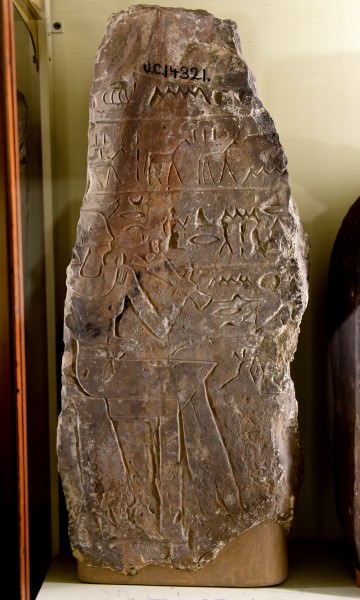
Egyptian stela from Intef blocks at a temple precinct
The second king of the 11th Dynasty, Menuhotep I (c. 2115 BCE) declared Thebes the true capital of Egypt and began the process of reunification by conquering neighboring nomes. This would continue through the reigns of the kings who followed him but especially by Wahankh Intef II (c. 2112-2063 BCE). Wahankh Intef II claimed the title of "King of Upper and Lower Egypt" and conquered the city of Abydos as one of his first acts. Abydos was one of the most ancient communities in Egypt where the early kings were buried, and in taking the city, Wahhankh Intef II was staking his claim as the rightful successor to these early rulers. With Abydos secured, he then waged war periodically with the rulers of Herakleopolis throughout his reign.
Wahankh Intef II was not merely a warlord or a provincial nomarch who had seized power. He considered himself a true king of Egypt and did his best to behave as one in keeping with the strictures and responsibilities of the past. He erected monuments and built temples to the gods, raising the first monument in honor of the god Amun at Karnak. He made sure his family, extended family, servants, and subjects were well cared for, and he maintained the principle of ma'at in his policies. In keeping with the paradigm of the best rulers of the Old Kingdom, Wahankh Intef II trusted only his closest family members and friends with power and delegated it sparingly. There were no powerful nomarchs in or around Thebes nor in any of the nomes taken under Theban rule. As Siedlmayer notes, Wahankh created a government which relied on "strong bonds of personal loyalty and on tight control" (Shaw, 126). This was precisely the policy of earlier kings such as Sneferu, Khufu, and Khafre of the Old Kingdom.
Upon his death, Wahankh Intef II was buried at el-Tarif outside Thebes with a biographical stele set up at the entrance.Siedlmayer writes:
This monument, which bears a depiction of the king accompanied by his favourite dogs, sums up in retrospect the accomplishments of his reign; and the statements made in the text are amply confirmed by the inscriptions of his followers. (Shaw, 125)
He was succeeded by Nakhtnebtepnefer Intef III (c. 2063 BCE), who captured Asyut from the Herakliopolitan kings and increased the reach of Thebes. His success was capitalized on by the great prince Mentuhotep II, who defeated Herakleopolis and united Egypt under his rule. Mentuhotep II was considered a 'second Menes' in later inscriptions and praised as the great king who had again brought order to the land. With Mentuhotep II's victory, the First Intermediate Period comes to a close and the period known as the Middle Kingdom begins. The developments of the First Intermediate Period would greatly influence the next era in Egypt's history. The rulers of the Middle Kingdom and the regional nomarchs would work together for most of the era to create some of the most impressive works of art and one of the most stable and affluent societies in history.
LICENSE:
Article based on information obtained from these sources:with permission from the Website Ancient History Encyclopedia
Content is available under License Creative Commons: Attribution-NonCommercial-ShareAlike 3.0 Unported. CC-BY-NC-SA License